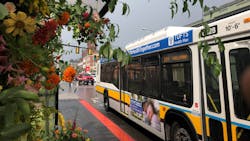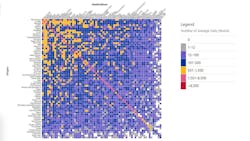Why COVID-19 should make transit rethink the fixed-route system
The COVID-19 pandemic has changed the way society thinks about so many social norms. A handshake. A busy restaurant. A packed subway car. As many U.S. states begin the important work of planning to safely reopen the country, public transit agencies must grapple with both the necessity and financial cost of increasing the physical distance between riders, as well as the psychological impacts of the pandemic on their ridership and staff.
This will not be an easy transition. Modern transit agencies have already faced significant challenges in recent years to effectively grow and serve their ridership—from finding the necessary funding to competition from private rideshare companies. However, COVID-19 represents the biggest challenge many have faced.
The Ingredients for Transit Success, Post- COVID
Many transit agencies are considering new ways to clean their vehicles throughout the day. Technology such as Germicidal UV-C or 405nm lighting can be employed in vehicles to disinfect surfaces at various times during the day or at the end of a route—when the bus is unoccupied—in order to create a safer, cleaner environment for both riders and drivers. While it is unknown if these types of lighting have been tested specifically on COVID-19 yet, it has proven to be successful in killing norovirus surrogates, bacteria and other viruses.
With that said, while the transit industry is doing all it can to be clean, and to be perceived as clean, the truth is that may not be enough. If travel patterns are undergoing a paradigm shift, then simply enhancing cleaning procedures while offering the same service doesn’t match the new reality.
To remain relevant, transit agencies must leverage available data and rapidly adopt new technology that gives riders what they need now more than ever: safer, faster and more convenient transport.
Rethinking and fixing the fixed-route system
Today, many transit agencies employ fixed-route systems. These routes operate on a predetermined route and schedule. In Denver, many of the routes still follow the old streetcar map from 1917. This is for good reason, as these are the major corridors through the city.
These fixed-route systems provide important mobility, especially between the suburbs and urban areas, bringing essential workers to their jobs in the city. But they often put people in a confined space for an hour or more and frequently require multiple transfers to get people to their destination.
It is safe to say transit riders will find this to be a less attractive travel option post-COVID-19. One solution is creating shorter, more frequent routes. This would allow people to be confined for less time and with fewer people. Agencies are already limiting the number of riders onboard at one time to allow for appropriate distancing, but primarily as a stopgap measure to keep service running. Some data-driven solutions have been coming to market to help agencies with that process, making real-time passenger counting more accurate. More sustainable solutions need to be applied that can help maintain and increase overall ridership, while prioritizing rider safety.
Successfully executing a modified route system requires that a transit agency first understand exactly where and when their riders need them most. One popular method uses anonymized cell phone data and mapping software. These algorithms utilize GPS data and can map travel needs throughout the day. Stantec employed this technology for the transit master plans for the city of Winnipeg and Lake Tahoe, Nev. The graphic below represents average daily movements and provides a compelling spatial relationship matrix.
Transit agencies will regularly take a fresh look at the service they provide, and some were already in the process of adjusting routes when COVID-19 hit. In January, Los Angeles County Metropolitan Transportation Authority, announced a draft plan to improve the frequency of buses across its system. If adopted, this plan would result in shorter waits for buses, more reliable service and faster door-to-door trips.
With riders now less inclined to spend long periods in confined spaces, route optimizations like this will become even more important for the future of public transit.
On-demand rides and dynamic scheduling
Beyond making sure riders feel safe by providing cleaner vehicles and shorter trips, transit agencies will need to rapidly adopt on-demand and dynamic scheduling. This isn’t news to transit agencies. Ever since Uber and Lyft came around, the writing has been on the wall. For several years now, transit agencies have been working out how to incorporate on-demand or dynamic scheduling into their offerings to serve ridership more effectively.
Implementing on-demand or dynamic scheduling requires an agency to first assess the type and level of software they will need. Fortunately, they don’t have to go out and create a custom solution as a growing number of software providers are addressing this market. For larger agencies that require more tailored solutions, there are companies that will customize software, such as MDData and Softbit Tech.
The elephant in the room here is, of course, cost. The good news is that the kind of smart technology solutions and data that will help agencies make more informed decisions does not have to be cost prohibitive. The key is to select the appropriate solution scale to match the needs of the agency. Stantec’s transit team covered this topic as part of an article series on microtransit. For example, in the case of hard costs like vehicles, more frequent routes can become expensive. In many cases, the trade-off could be using smaller, less expensive vehicles.
As cities reopen, the need for safe, cost-effective transport is more essential than ever. While many of these changes have been in the works, this pandemic has accelerated the need. The way transit agencies respond today—rethinking fixed routes, keeping riders and drivers safe and exploring new modes of delivery—will ensure public transport remains viable for a new generation.
------------------------------------------------------------------
Merlin Maley is a principal with Stantec, focusing on transportation and municipal/utility maintenance and operations facilities, multi-modal stations and facility master plans. He’s based in Denver, Colo.

Merlin Maley | Principal, Buildings, Stantec
Driven by a deep interest in creating more sustainable communities through improved mobility, Merlin has dedicated more than a decade of his career to the transportation and public sector industry. Through his transit systems work, he is helping to create 21st century cities and communities while decreasing dependence on single-occupancy vehicles for mobility.
Merlin focuses on transportation and municipal/utility maintenance and operations facilities, multi-modal stations, and facility master plans. His design process looks at life cycle costs and blends functionality, safety, sustainability, and budget to reduce annual operational costs, and improve culture and morale for his clients.




